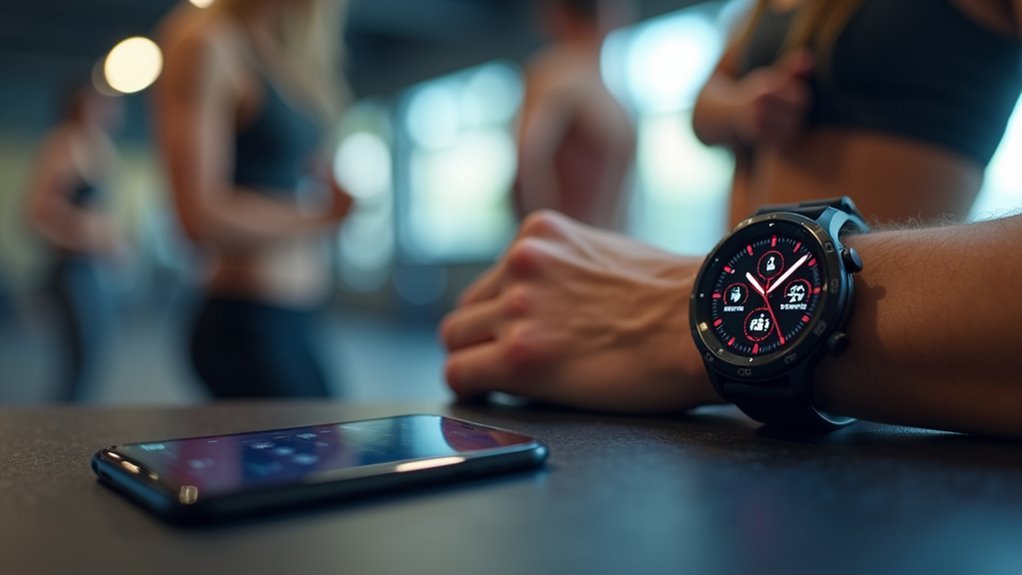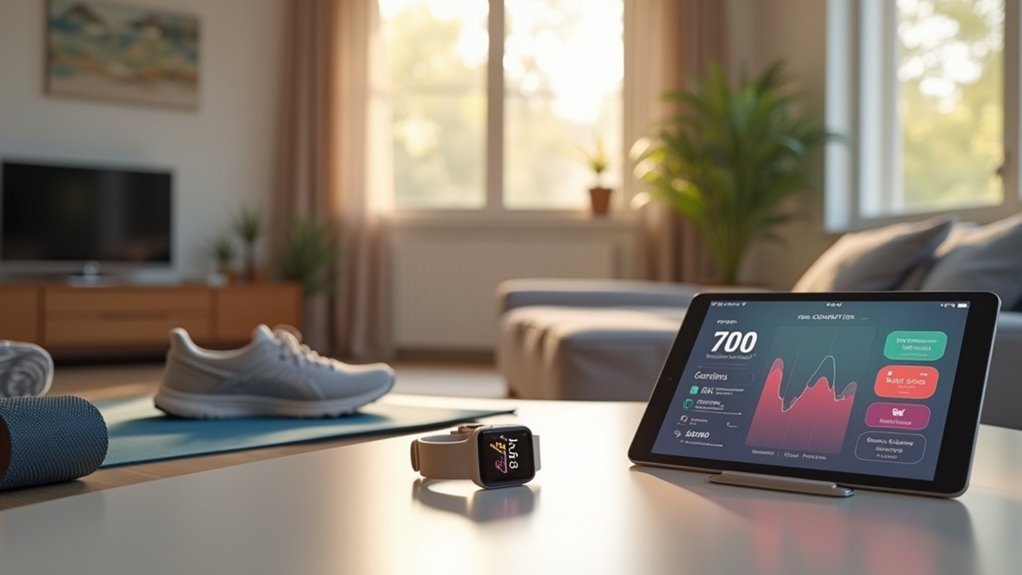You can achieve seamless fitness data flow across device ecosystems by using integration platforms like FitnessSyncer and Terra API, which connect over 50 health providers into unified dashboards. These solutions overcome fragmentation challenges through standardized APIs and real-time synchronization, transforming data from Garmin, Fitbit, and Apple devices into actionable insights. Advanced analytics and customizable dashboards let you visualize extensive health metrics while AI algorithms predict patterns and optimize your training. Discover how emerging technologies will revolutionize your fitness experience.
The Evolution of Multi-Device Fitness Tracking
Although today’s fitness enthusiasts take seamless data synchronization across multiple devices for granted, this interconnected ecosystem emerged through decades of technological evolution.
You can trace the journey from simple 1960s pedometers that counted steps to sophisticated multi-sensor networks. The 1982 Polar PE2000 introduced precise heart rate monitoring through radio chest straps, while GPS integration in the 1990s enabled route tracking.
The groundbreaking Nike+iPod collaboration in 2006 demonstrated cross-device data sharing between footwear sensors and music players. When the iPhone launched in 2007, smartphones became central hubs using built-in accelerometers.
Fitbit’s Bluetooth-enabled trackers then introduced seamless wireless syncing, creating the foundation for today’s extensive multi-device fitness ecosystems you rely on daily. By 2010, logging apps enhanced social sharing and competition features across platforms.
Understanding Cross-Platform Data Integration Challenges
While the fitness tracking ecosystem has matured remarkably over the past few decades, integrating data across multiple platforms presents significant technical hurdles that can frustrate users and developers alike.
You’ll encounter varied device sensors that produce inconsistent accuracy across different brands and models. Operating system fragmentation means you’re dealing with multiple Android, iOS, and wearable OS versions requiring constant updates.
Data formats differ dramatically between platforms, creating integration barriers when date structures and field schemas don’t align.
You’ll find API availability varies widely—some vendors offer robust integration options while others provide limited documentation. The absence of universal compatibility standards among fitness app developers further compounds these technical barriers.
Wearable connectivity protocols like BLE and ANT+ aren’t universally supported, forcing developers to accommodate multiple wireless standards.
These compatibility issues multiply sync failure points and often result in duplicated or missing workout data.
Popular Integration Platforms Transforming Health Data Management

You’ll find that platforms like FitnessSyncer are revolutionizing how your health data moves between devices and applications.
These integration solutions connect your fitness trackers, smartwatches, and health apps automatically, eliminating the manual data entry that’s plagued users for years.
What’s transforming the landscape isn’t just connectivity—it’s the combination of real-time synchronization, customizable dashboards, and analytics tools that turn your scattered fitness data into actionable insights. With AI algorithms now capable of predicting health conditions and analyzing patterns in real-time, these platforms are moving beyond simple data aggregation to provide genuine health intelligence.
FitnessSyncer Cross-Platform Connectivity
When you’re juggling data from multiple fitness apps and devices, FitnessSyncer emerges as a powerful solution that connects over 50 health and fitness providers into one unified platform.
You’ll find extensive integration with popular services like Fitbit, Garmin Connect, and Strava, plus beta support for emerging platforms like Huawei Health.
The FitnessSyncer Stream centralizes your health data management, while customizable dashboards let you visualize metrics through graphs and KPIs tailored to your needs.
You can configure destination tasks to synchronize data across multiple platforms automatically, ensuring seamless cross-service connectivity.
Pro users access scheduled syncs, auto-sync capabilities, and enhanced dashboards for deeper analysis.
When devices miss capturing data, you’ll use the FitnessSyncer Notebook for manual entries, maintaining complete records across your fitness ecosystem. The platform also enables secure sharing of your activities and progress dashboards with friends, family members, and healthcare providers for enhanced support and accountability.
Multi-Device Data Synchronization
Managing fitness data across multiple devices creates a complex web of synchronization challenges that modern health platforms are rapidly solving through innovative integration solutions.
You’ll encounter diverse operating systems and data formats that complicate seamless connectivity, while network issues can disrupt real-time tracking. Terra API addresses these challenges by providing unified integration with Garmin, Fitbit, and Apple devices through robust protocols.
Popular platforms like Strava excel at multi-device syncing for running and cycling activities, while Health Sync dominates Android integration. This comprehensive compatibility extends across multiple app stores including Play Store, App Store, and Huawei AppGallery with support for major fitness platforms.
You’ll benefit from automated logs that capture equipment performance data and offline syncing capabilities like Nike Run Club’s Bluetooth transfer.
These solutions implement unified data layers with encryption security, ensuring your health metrics remain consistent and private across your entire device ecosystem.
Customizable Analytics Dashboards
Modern health platforms excel at collecting synchronized data, but transforming that raw information into actionable insights requires sophisticated analytics dashboards that adapt to your specific needs.
You’ll find drag-and-drop widget creation lets you personalize views instantly, while role-based dashboards guarantee clinical staff, admins, and patients each access relevant workflows. Whether you’re managing a longevity clinic, concierge practice, or biohacking program, you can select pre-built templates or create fully custom builds.
Your dashboard consolidates appointments, follow-ups, lab results, and alerts in one unified view. Real-time patient insights and cohort analysis help you track improvements across groups, while trend visualizations reveal patterns in lifestyle and clinical markers.
You’ll export reports to Excel, PowerPoint, or PDF for seamless documentation and program validation. These comprehensive reports strengthen patient-doctor relationships by providing detailed progress summaries that facilitate more meaningful consultations and personalized care discussions.
Smart Wearables Market Growth and Adoption Drivers

The explosive growth of smart wearables represents one of today’s most dynamic technology markets, with valuations skyrocketing from USD 109.34 billion in 2023 to a projected USD 303.98 billion by 2029. You’re witnessing this remarkable 18.58% CAGR driven by powerful technological forces transforming how we interact with fitness data.
| Growth Driver | Impact on Adoption |
|---|---|
| AI Integration | Enhanced user experiences and personalized insights |
| 5G Networks | Improved operational efficiency and real-time data sync |
| IoT Infrastructure | Seamless device connectivity across ecosystems |
Key market segments you’ll encounter include smartwatches, hearables, and health rings, each offering unique data collection capabilities. Major players like Apple, Samsung, and Xiaomi continue driving innovation through beacon technology and payment integration, making wearables indispensable tools for extensive fitness tracking across interconnected device ecosystems. The earwear segment dominates market revenue with over 51% share in 2023, fueled by remote work trends and comprehensive health tracking capabilities.
Garmin’s Approach to Cross-Device Activity Syncing
When you’re juggling multiple Garmin devices throughout your day, TrueUp’s multi-device activity sync guarantees you’ll never see duplicate activities cluttering your fitness data.
The system automatically selects the most accurate data source when multiple devices record simultaneously, while you can designate a “Preferred Activity Tracker” to resolve conflicts according to your priorities.
Garmin Connect serves as your central hub, consolidating data from diverse wearables, cycling computers, and fitness trackers into one unified account.
Garmin Connect unifies all your fitness devices into a single, comprehensive dashboard for seamless data management.
You’ll experience seamless device switching while maintaining complete activity history. However, the system has tracking limitations that focus primarily on arm movements, potentially missing activities like cycling and yoga when measuring intensity minutes.
- Conflict Resolution: Prioritizes data from user-designated preferred devices and sensor accuracy
- Real-Time Integration: Updates activity stats across all devices and Garmin Connect backend instantly
- Unified Training Experience: Reflects recent activities from paired devices on your primary wearable
Apple Health App’s Multi-Source Data Prioritization System
Unlike Garmin’s TrueUp system that automatically selects the most accurate data source, Apple Health requires you to manually configure data source priorities through its “Data Sources & Access” settings.
You’ll need to tap “Edit” and drag sources into your preferred order, determining which devices take precedence for data collection.
However, you’ll likely encounter frustrating limitations with this system. The Apple Watch consistently reverts to top priority, overriding your manual adjustments.
You can’t easily disable certain older devices, and priority changes don’t always sync consistently across your Apple devices. This creates data accuracy issues when you’d prefer prioritizing third-party apps or other sources over your Watch.
While Apple Health integrates well within the ecosystem, managing multi-source priorities remains challenging. Third-party fitness apps may experience calorie count reductions in the Fitness app even after initially matching post-workout values.
Advanced Analytics Tools for Comprehensive Fitness Insights
You’ll transform your collected fitness data into actionable insights through advanced analytics tools that go beyond basic step counting.
These platforms let you create personalized dashboards that spotlight the metrics you care about most, whether that’s heart rate variability, sleep quality, or workout performance trends.
You can visualize complex data patterns through interactive charts and graphs that reveal connections between different aspects of your health you might’ve never noticed. Advanced systems utilize AI integration to analyze vast amounts of your personal data and provide tailored recommendations for optimizing your fitness journey.
Deep Data Visualization
As fitness data becomes increasingly complex and voluminous, advanced visualization tools transform raw numbers into compelling visual stories that reveal hidden patterns in your health journey.
These sophisticated platforms turn overwhelming datasets into interactive dashboards, heat maps, and real-time feeds that make sense of your performance metrics across multiple devices.
You’ll discover trends you never noticed before through drag-and-drop interfaces that don’t require technical expertise. Tools like Tableau, Power BI, and Grafana seamlessly integrate data from various fitness ecosystems, providing extensive insights into your activities. These platforms excel at data integration and processing, handling the complex task of merging information from multiple fitness devices and applications into a unified analytical framework.
- Real-time feedback capabilities enable immediate workout adjustments and performance optimization
- Pattern recognition features identify correlations between exercise habits, diet, and recovery metrics
- Predictive modeling integration forecasts future performance trends and potential health outcomes
Customizable Dashboard Creation
When you’re managing fitness data from multiple sources, creating personalized dashboards becomes essential for transforming scattered metrics into actionable insights. You can drag-and-drop charts and widgets to arrange your preferred layout, prioritizing metrics like steps, calories, heart rate, and sleep based on your current goals.
The system lets you create unlimited dashboards, saving multiple configurations for different fitness objectives or timeframes. You’ll find customizable date ranges and preset views enable focused analysis on specific periods or activities.
Widgets dynamically populate based on your available data, ensuring blank fields don’t clutter your display. Advanced filtering by activity type allows targeted insights, while real-time chart updates provide instant feedback as you apply filters, making your fitness tracking more efficient and meaningful. The dashboard features temporal aggregation options for daily, weekly, and monthly views to analyze long-term patterns effectively.
Customizable Dashboards for Enhanced Data Visualization
Modern fitness enthusiasts demand more than basic data displays—they need intelligent dashboards that transform raw metrics into actionable insights.
You’ll discover that customizable dashboards revolutionize how you interact with fitness data by offering interactive visualization tools, real-time updates, and personalized layouts tailored to your specific goals.
These dashboards integrate data from multiple fitness platforms, creating a centralized hub where you can analyze trends, track performance metrics, and make data-driven decisions about your training routine. Drawing from 162 designs and illustrations, developers continuously innovate dashboard interfaces to meet evolving user expectations.
Key visualization features that enhance your fitness tracking experience:
- Interactive charts and graphs that let you explore deeper into your performance patterns
- Customizable color schemes and themes for aesthetic personalization
- Device-compatible interfaces ensuring seamless access across smartphones, tablets, and computers
Technical Solutions for Seamless Brand-Agnostic Compatibility
You’ll need robust API integration standards to connect fitness devices and apps across different brands without compatibility issues.
Cross-platform data protocols guarantee your health metrics flow seamlessly between wearables, gym equipment, and mobile applications regardless of manufacturer.
These technical foundations let you switch between devices or use multiple brands simultaneously while maintaining complete data continuity. ActiveOS demonstrates this capability by integrating dozens of different wearable sensors and fitness applications into a single centralized platform.
API Integration Standards
Since fitness ecosystems traditionally operate in silos, API integration standards have emerged as the cornerstone solution for achieving seamless brand-agnostic compatibility across diverse device manufacturers.
You’ll find that standardized APIs like Terra eliminate the complexity of managing multiple data formats by providing unified access methods regardless of your device’s brand. These standards guarantee your app can process data from dynamometers, force plates, wearables, and body composition analyzers through consistent protocols.
Modern API integration standards deliver three critical capabilities:
- Standardized Data Formats – Converting diverse device outputs into uniform structures for efficient processing
- Multi-Platform Support – Enabling connectivity across Android Wear, iOS devices, and third-party fitness trackers
- Real-Time Processing – Facilitating immediate data flow for features like autopilot workout modes
The foundation of these integration standards relies on streaming protocols that enable real-time data transmission from wearables through BLE and ANT+ connections, ensuring immediate availability of health metrics across all connected applications.
Cross-Platform Data Protocols
While API integration creates the foundation for unified data access, cross-platform data protocols handle the intricate technical layer that enables your fitness devices to communicate seamlessly regardless of manufacturer.
You’ll benefit from industry-standard protocols like Bluetooth Low Energy and RESTful APIs that prioritize data accuracy while minimizing latency and maximizing energy efficiency on your wearables.
Service-oriented architectures provide the modular framework you need for extendability across different platforms and brands.
Vendor-neutral communication layers prevent you from getting locked into proprietary ecosystems, ensuring your data flows freely between heterogeneous devices.
These abstraction layers create seamless compatibility while maintaining the precision essential for reliable fitness tracking across your entire device ecosystem. Implementing consistent IDs across your fitness platforms ensures that your workout data, heart rate metrics, and activity logs are properly linked regardless of which device captures the information.
Future Trends in Ecosystem Expansion and Community Features
As the fitness industry continues its digital transformation, you’re witnessing an unprecedented convergence of wearable technology, artificial intelligence, and community-driven platforms that’s reshaping how fitness data flows between devices and users.
The market’s explosive growth—with fitness equipment reaching $19.2 billion and digital fitness growing at 33.1% annually through 2027—signals massive ecosystem expansion ahead. Recovery strategies including foam rolling, massage guns, and cold therapy are becoming mainstream integration within these comprehensive digital platforms.
You’ll experience three transformative trends:
- AI-Powered Personalization: Hybrid models will leverage AI to create hyper-personalized experiences that seamlessly blend virtual and in-person training while maintaining continuous data flow across all touchpoints.
- Inclusive Virtual Communities: Platforms will foster global networks supporting diverse needs from prenatal to senior fitness, enabling real-time group challenges and accountability through shared data ecosystems.
- Integrated Wearable Analytics: Next-generation wearables will provide sophisticated health tracking with seamless cross-platform synchronization.
Frequently Asked Questions
How Do I Transfer My Fitness Data When Switching From Android to Iphone?
Use Move to iOS app for basic data, but you’ll need third-party tools like MobileTrans or manually export fitness data. Cloud-enabled apps like Strava sync automatically when you log in.
Can I Sync Fitness Data Without an Internet Connection or Wi-Fi?
You can’t sync fitness data without internet or Wi-Fi since syncing requires connectivity to transfer data between devices and cloud services. However, you can collect and store fitness data locally offline until connection’s restored.
What Happens to My Data if a Fitness App Shuts Down Permanently?
When a fitness app shuts down permanently, you’ll typically receive advance notice. The app should delete your data per privacy regulations, but you’ll often get options to export your information beforehand.
How Do I Resolve Conflicts When Devices Show Different Calorie Counts?
You’ll need to identify which device’s most accurate for specific activities, manually cross-check readings against known benchmarks, and choose one primary device as your standard while treating others as secondary references.
Which Fitness Trackers Work Best for People With Pacemakers or Medical Implants?
You’ll need to consult your healthcare provider before choosing any fitness tracker, as limited data exists on safe options. Avoid devices with strong magnets and prioritize those with minimal electromagnetic interference potential.
In Summary
You’re witnessing a transformation in how fitness data flows between devices. You’ll benefit from platforms that break down brand barriers, letting you track workouts seamlessly across ecosystems. You can expect smarter analytics, customizable dashboards, and community features that’ll enhance your fitness journey. Don’t let device compatibility limit your progress—embrace integrations that work for you. Your health data should move as freely as you do, creating thorough insights that drive better results.





Leave a Reply